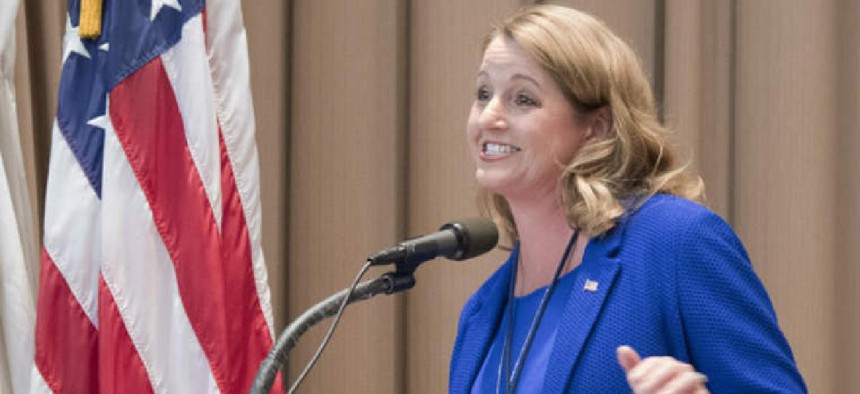Why IT modernization needs more women

"We're embarking on the largest transformation in the world," federal CIO Suzette Kent said. "Women are more effective collaborators, and what you deliver is actually better."

Federal CIO Suzette Kent at an event for women in federal IT at USDA. (Photo courtesy: GSA)
IT modernization and workforce transformation are key pillars of the recently released President's Management Agenda. Federal CIO Suzette Kent thinks success on both fronts is far more likely if more women are in the driver's seat.
"Why are women so important in that journey?" Kent asked at the Federal CIO Council's March 29 event focused on women in federal IT and cybersecurity.
"We're embarking on the largest transformation in the world. … Women are more effective collaborators, and what you deliver is actually better."
Joanne Collins Smee, the General Services Administration's acting director of the Technology Transformation Services, made a similar argument. "The issues we have in the government are not technology issues," she said. "They require collaboration and persistence to be able to make the technical changes."
The March 29 event was part celebration of women already in tech, and part recruiting effort to bring more females into the field. And while the speakers -- which also included deputy federal CIO Margie Graves and a half-dozen agency CIOs -- discussed the importance of flexible hiring authorizes and better recruiting efforts, much of the discussion focused on the individual efforts and attitudes needed to help talented women advance in tech.
"Let's be honest," NASA CIO Renee Wynn said. "I have an economics degree and a bachelor of arts. No science, no nothing. But … I certainly know how to persevere."
Small Business Administration CIO Maria Roat, Interior Department CIO Sylvia Burns and Health and Human Services Department CIO Beth Killoran all echoed Wynn's point. Each noted that her career was a series of zig-zags and opportunities seized, not some well-planned STEM advancement path.
And Graves -- who does have a hard-science background -- stressed that it's important for leaders to encourage women to seize those opportunities even if they feel they're not perfectly qualified. Research studies have shown that men are far more likely to apply for jobs where they lack some of the stated qualifications, while women may hesitate even when they meet all the criteria.
Graves recalled a former employee at the Department of Homeland Security, where she was deputy CIO before moving to her governmentwide role. "She did not think of herself of a data scientist," Graves said, but everything about her job was essentially data science. And when a chief data officer position came open in another agency, the employee did not want to apply.
"I'm not a data scientist, I don't have a degree, they're not going to consider me," Graves said of the woman's objections. "I said, 'No, you go and you tell them what you've been doing.' And she's there at HHS today."
In a discussion with reporters after the event, Kent and Killoran agreed that such mentoring and give-it-a-try attitudes are critical, but also acknowledged that the government's human capital needs demand what Kent called "industrialized" efforts to support the individual commitments.
"The administration is going to be working across OMB and [the Office of Personnel Management] to figure out how we make some of those process and policy changes internally," Killoran said. CIOs are probably "not doing as much as we can" with existing hiring authorities, she added.
Kent promised to make the event an annual affair, and predicted there would be significant process to share at the 2019 edition. Conversations are already underway, she said, with a particular emphasis on hiring authorities and emerging tech roles that agencies will need to fill.
"We are looking at what we can do with special authorities," Kent said, "and working with OPM on ways that we can be more creative."





